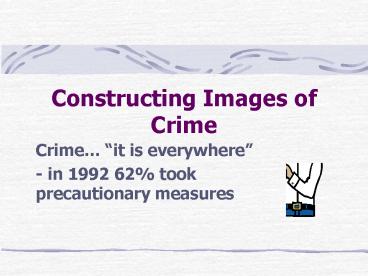Constructing Images of Crime - PowerPoint PPT Presentation
Title:
Constructing Images of Crime
Description:
in 1992 62% took precautionary measures. Crime Data ... deep sense of guilt. exaggerate. BUT, many improvements ... impression and first hand. face validity ... – PowerPoint PPT presentation
Number of Views:25
Avg rating:3.0/5.0
Title: Constructing Images of Crime
1
Constructing Images of Crime
- Crime it is everywhere
- - in 1992 62 took precautionary measures
2
Crime Data
- How much crime is there?
- What are the patterns and trends in crime?
- Who commits crime?
- What is the nature of criminality?
- make up the study of criminology
- --- try to be objective in answering
3
Purpose of Crime Data
- Another sub-area of the criminological enterprise
- we try to generate reliable and valid data
- FIVE key purposes
- 1. Descriptive
- 2. Explanation
- 3. Program evaluation
- 4. Risk assessment, and
- 5. Prediction.
4
www.ecriccanada.com/geoprof.htm
- Kim Rossmo and geoprofiling (Box 3.3)
- descriptive to prediction
- hi-tech crime fighting strategy
- integrates theory and practice
- reduce false positives
- Ethic concerns?!
- Future implications (DNA, forensics, satellite
tracking, etc.)
5
The looking glasses of crime
- Defining
- Actual crime
- Official crime
- Dark figure
- Official Sources
- .. . Huff 54 secret language of statistics
- reality is merely an appearance of something
more real
6
Police Data
- Although NOT the first, today the most frequently
used form of official data - Address the dark figure
- UCR
- History
- 1962 and standardization
- Summary vs. indictable offences
7
Judicial Data
- France and Compte General in 1825
- The work of Guerry and Quetelet
- Canada began collection 1876
- Role of the CCJS
- Growth of Legal Aid vs. court costs
- Examine sentencing lengths
8
Correctional Data
- English prison data as early as 1836
- Demographic and socio-economic information
- From Prison Statistics to CCJS
- Federal vs. Provincial data
- Info re incarceration rates, expenditures, inmate
profiles, etc.
9
The limits of Official Data
- Data reflect official responses to social
behaviours as defined by the Criminal Code - Crime Funnel (Table 3-4)
- Suggestive rather than declarative
- artificial fluctuation
- Public interest, police enforcement practices,
recording procedures
10
Crime rates drop 6th year - 98
- WHY?
- Linden 96 just getting too old
- Foot 96 shift in demographics
- RAT shift in opportunity
- if demographic can predict how use in policy???
11
- To calculate crime rates
- of reported crimes
- R/100 000 ----------------X 100 000
- total population
- !! Census ever 10 years, mini 5 yrs.
- reported vs. charges
12
Canadian Centre for Justice Statistics
- History 1974-1981 a need for a central
information collection and dissemination centre - 1981 Juristat Bulletins
- Yet limitations no uniform court data, limited
insight in crime and criminal behaviour, nothing
on white collar crime, organized crime,
victimless crimes
13
- See Box 3.6
- CCJS continues to evolve
- CCJS a primary source of official data
- Quality of data improving but theoretical
foundation still lacking - Relevance of unofficial sources
14
Victimization Data
- Pioneers Ezzat Fattah, Hans Hentig, and Stephen
Schafer all European heritage - overlooked in N.A. until recently
- OBJECTIVES
- measure extent and distribution of selected
crimes - impact risk of victimization indicators of CJ
functioning
15
- GSS 88, 93, 98 (Box 3.7)
- CUVS 81-88 (Box 3.8A)
- VAWS 96 (Box 3.8B)
- Left Realism and Feminist T
- ICVS Jan van Dijk (NL) 17 to 54 countries
participate - Caution
- !sampling, questions, memory, urban, types of
crime
16
Self-Report Data
- Thorsten Sellin 31 1st to suggest importance
- pragmatic approach to enumeration
- focus groups diverse BUT young offenders
- males, urban, property crimes, illuminate the
dark figure
17
- Methodological issues
- comparability
- standardization
- different interests
- honesty
- trust interviewer
- deep sense of guilt
- exaggerate
- BUT, many improvements
- DeKeseredy and abuse Farrington youth
corporate crime
18
- Observational Procedures
- field research
- data directly
- impression and first hand
- face validity
- Humphrey and tearoom (Verstehen, symbolic
interactionism ) - Types non-participant participant
- triangulation
- convergence-discriminant validity
- dark figure
- Research methodology and epistemology
19
Objectives and Purpose
- Correlates of crime
- Cause vs. probability
- Discovery
- Demonstration
- Refutation
- Prediction
- RESEARCH METHODOLOGY - theory
20
Summary
- Describe and evaluate the four main methods of
gathering and interpreting data - each has strengths and weaknesses
- choice depends on resources and objectives
- criminologists take sides
- Need for integration and interdisciplinary
21
See you next class...































